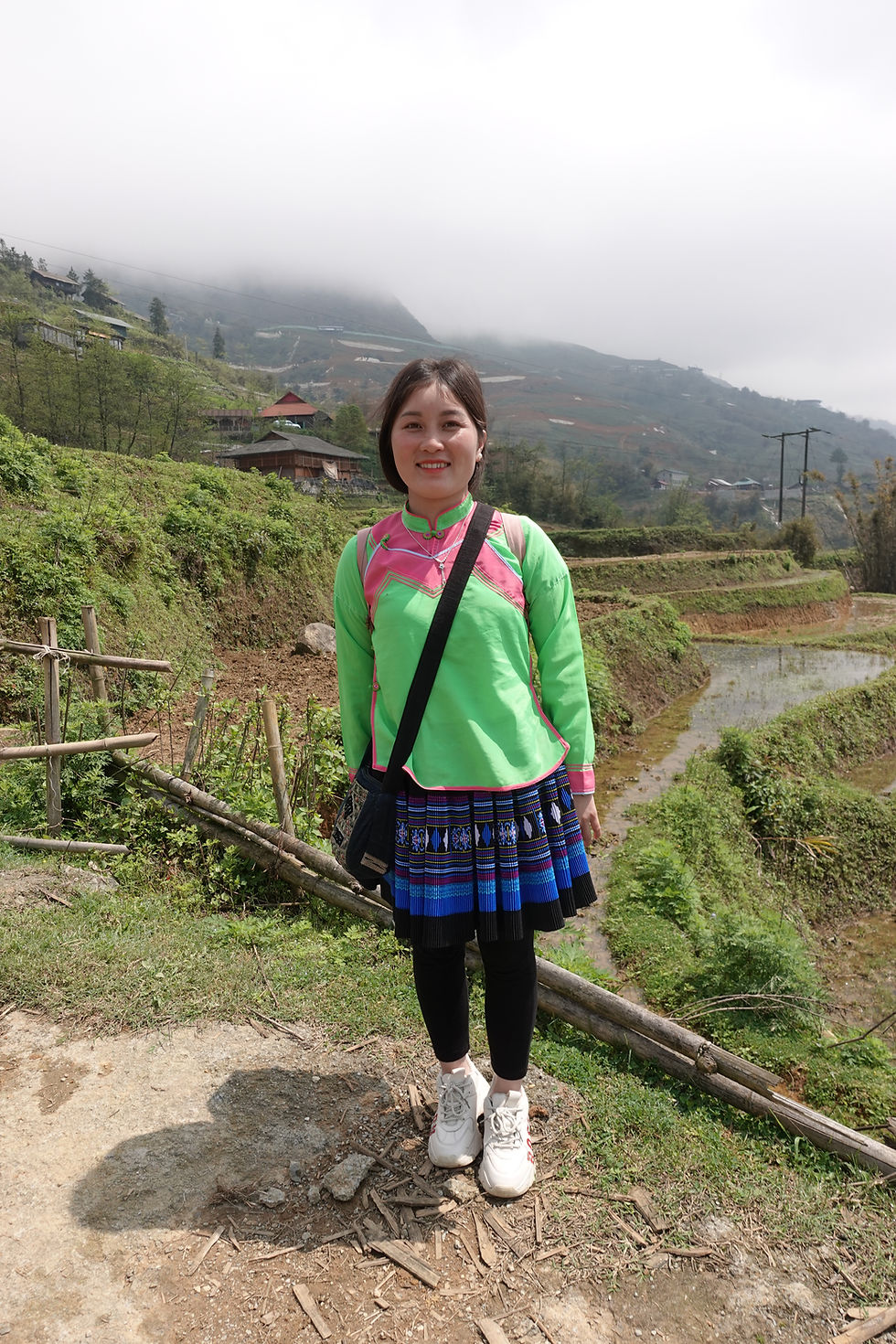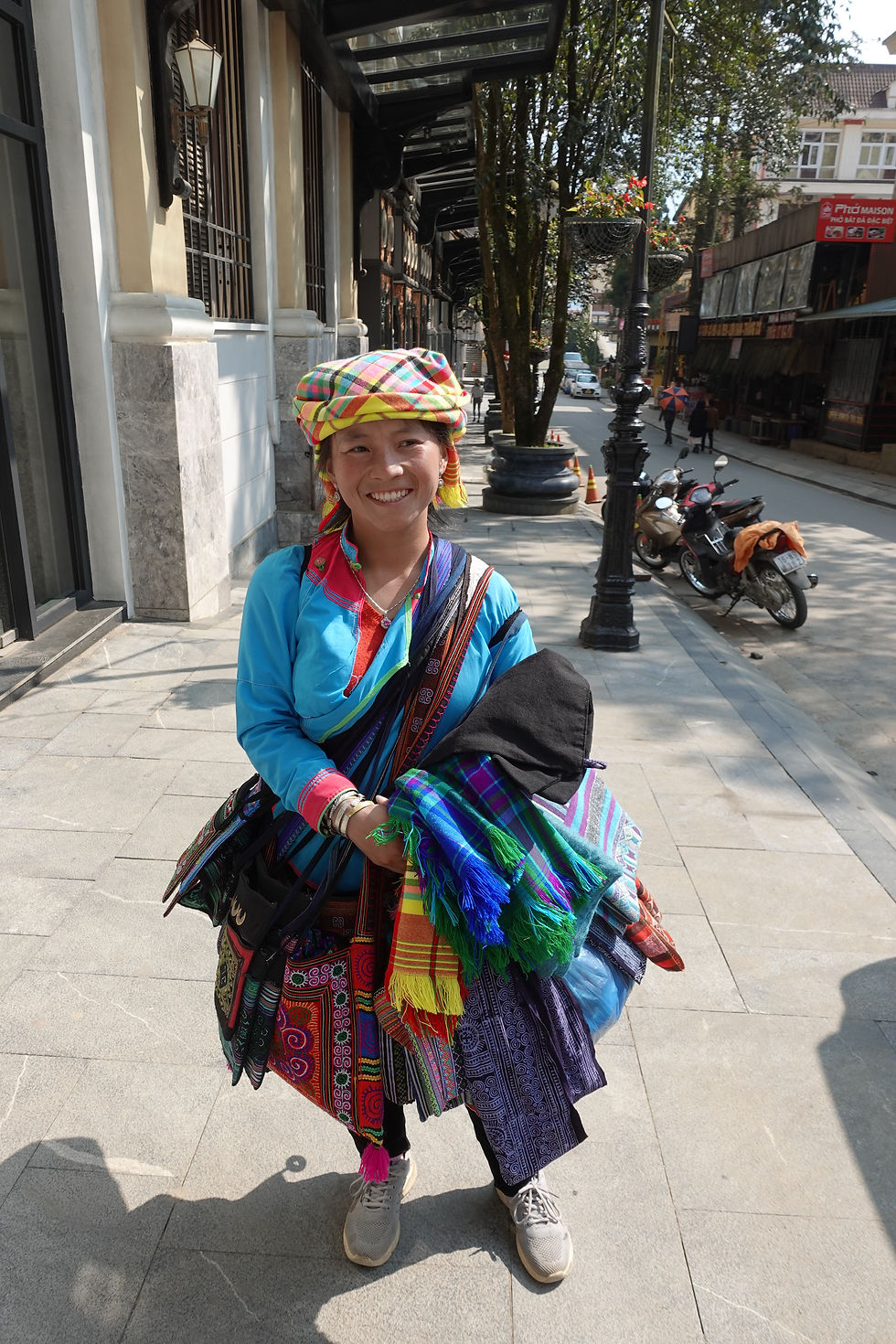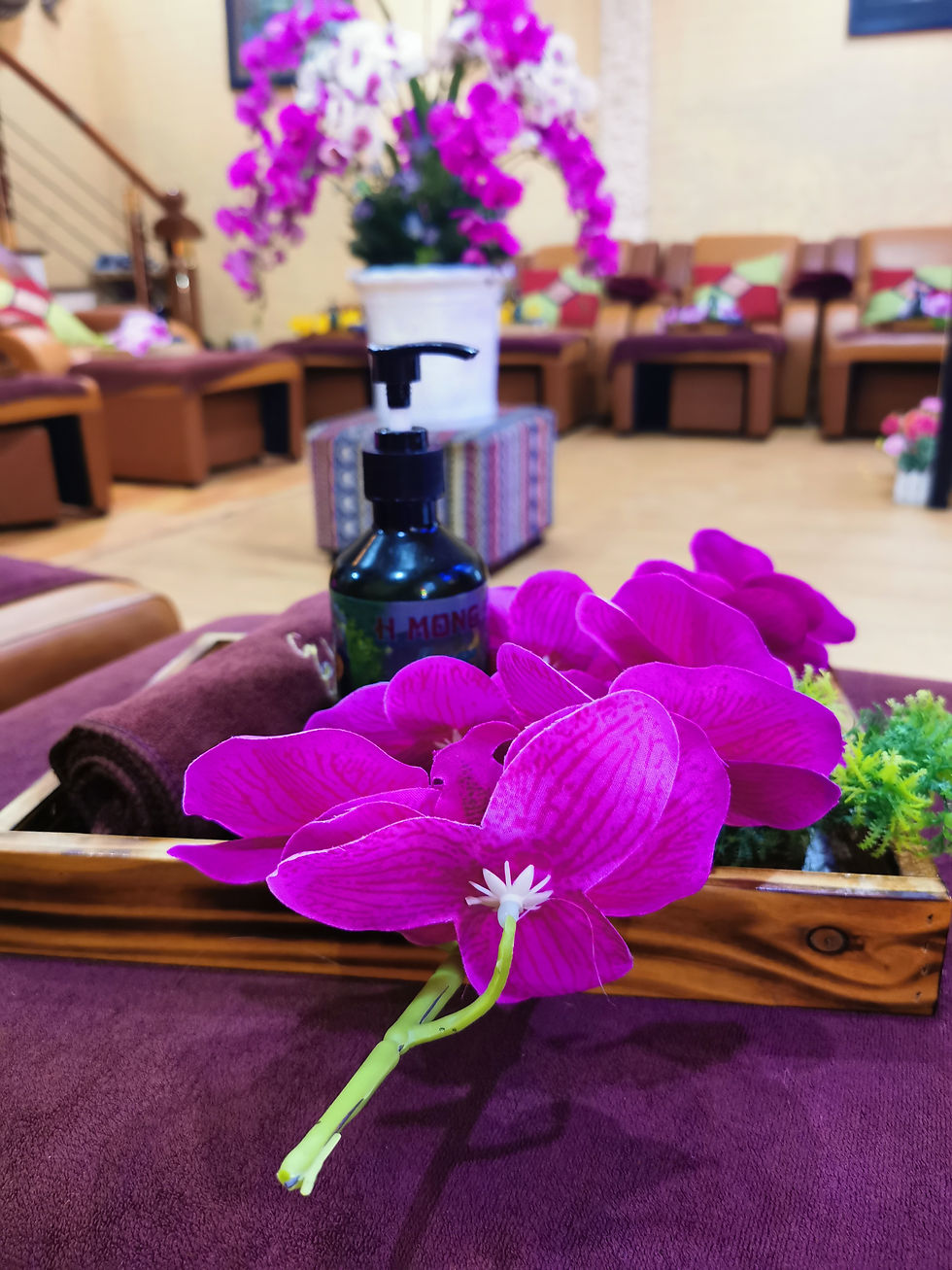Blog Series Vietnam – Part 3 – The spectacular mountain area of Sapa
- Marion Mueller

- Nov 12, 2023
- 7 min read
Updated: Mar 6
This is the continuation of my Vietnam Blog Series, for all general information please refer to Part 1.
It is time now to leave the urban areas and to explore a more rural part of Northern Vietnam. The scenic mountain landscape of Sapa is stunning, however also here mass tourism has made its way into the valleys. Especially the area around the mountain city of Sapa has been a summer retreat for stressed city people since long. Visitors are coming to enjoy the much cooler climate and the lush green vegetation.
Sapa town overlooks the deep Moung Hoa Valley with its magnificent rice terraces that are still farmed today as they have been for centuries. Backdrops don’t get much more spectacular. White-water rivers rush among rice fields, and lush green mountains stretch into the distance as far as the eye can see. The highest peak in the region, Mount Fansipan, crowns the ragged ridge line high above town. Sapa became nowadays also a popular trekking base.
How to get there
As a car or bus drive from Hanoi is very tiring and takes a lot of time, best option to reach would be by train. Most convenient is to use the night train, which runs every night between Hanoi and Lao Cai Station and vice versa (departure is around 22.00 hrs arrival around 06.00 hrs).
There are various tour operators offering sleeping cabins on the train – each own one or two train waggons. Depending on the company the cabin design and amenities will vary. You can usually book a private cabin for 1 – 4 passengers. There will be 2 public toilets and a simple washing facility per waggon.
We were booked on the Chapa Express Train www.chapaexpresstrain.com.vn – I was really surprised about the cosy and nice-looking cabins. Attention with the luggage – there is almost no space for it. We were two people and could hardly squeeze our two suitcases under the beds, with 4 people in a cabin that will be difficult.

There are snacks on offer, plus before arrival tea and coffee is served. The train journey is fun – especially the first part when leaving Hanoi and when passing through the narrow train street – however don´t expect to sleep in there!!! The train especially when it goes faster outside of the cities is extremely noisy and instable due to the old rail tracks – so it was an adventure and nightmare at the same time.
From Lao Cai Station you can use the public bus service to Sapa or arrange your driver over a tour company or the hotel. Drive time is around 90 minutes.

Where to stay
Sapa has a wide range on all sorts of accommodation types starting from simple lodges and hostels over smaller economic hotels to brand new 4 and 5* hotels.
We stayed at the tasteful Pistachio Hotel 4* (www.pistachiohotel.com).

The hotel offers spacious rustic rooms with an open bath concept. Throughout the hotel you can find an appealing mountain design that features the tribal history of the region as its main theme.
Within the hotel you have a panoramic restaurant for breakfast, lunch and dinner plus a scenic rooftop bar.
Highlight of the hotel – the small, but very spectacular infinity pool.
For cooler days the hotel has also an indoor pool plus a small Spa area.

Another recommendation for a luxury hotel in Sapa would be the MGallery Hotel de La Couple 5* (www.hoteldelacoupole.com) – located in the old train station, where you can indulge in a nostalgic Indochina feel.
What to do in Sapa?
In general with some planning ahead you can arrange your itinerary for yourself or in my opinion better check with one of the local companies. Our local guide Tung Giang was a blast and one of the sweetest guides I ever had. She took great care of us and introduced us to her local culture and tradition in a very charming way.

Go on a trekking tour
The area around Sapa is trekkers paradise – there is an endless variety of day-treks as well as tours that are going over multiple days and include camping/staying in guest houses.
We just opted for a very easy hike from Lao Chai Village down into to the Muong Hoa Valley (2-3 hours). As the routing is downhill it is much more of a scenic walk than a sportive activity. But the scenery of the vast rice paddy terraces with the impressive mountain panorama in the backdrop is worth to take things slow – in order to soak in every single picture.

For the rice terraces best time would be a visit between May to October, when you can observe how the locals do the planting and harvesting, one of the most important activities in the daily life. That will be also the time when you can experience the lush green colours of the rice fields. As our visit was end of March there was unfortunately no rice planted and the dry landscape showed itself in more brownish colours.
Best experience that you will have on any walk in the valley is to get in touch with the local tribe community. At the Moung Hoa Valley you will mainly meet the Black Hmong – one of the biggest minorities that still keeps their culture and way of living with pride. They have their own language and wear traditional indigo blue cloth.
Moreover you will meet the Giay – a fairly small minority group of about 38 000 people. Some of their old customs have been lost, but many women still wear traditional shirts with purple, blue or green colour. The Giays houses are built of wood and bamboo with clay floor.
All these people are minorities and are facing difficult life conditions and most of them are fairly poor. In each passing tourist they see a small chance to increase their income a bit with the selling of some traditional items. If you like to get a souvenir, then better buy directly from them than in one of the shops in Sapa city.

If you like to experience an unique gathering of the various tribes of all valleys around a visit to the Dong Van Hill Tribe market, which takes place every Sunday, is highly recommended. (However it is around 3 hrs/way drive away from Sapa). I found this nice Travelblog for more information www.originvietnam.com/destination/vietnam/ha-giang/dong-van-market.html
At the end of our hike, we reached Ta Van Village – a walk through there gives a very good impression of the daily farmer`s life.
Take the cable car up to Fansipan Mountain (www.fansipanlegend.sunworld.vn/en)
Fansipan is the highest peak in Vietnam and has already from far a very spectacular shape. Previously it took two-days of hard trekking to reach the peak – so this spectacular mountain scenery revealed itself only to few sportive people. However, this changed dramatically with the opening of the cable car – which catapults nowadays a huge number of visitors to the peak. On top you will find yourself in a mini-Disneyland – a quite sad example how nature gets commercialized. Of course, the view from the top is still amazing – but it is everybody’s own choice if you like to support developments like that. We didn´t.......
From Sapa Village you can take the mountain railway down to the base of the cable car. In the peak season and on weekends long waiting times can be expected – especially due to the fact that the cable car has often to be stopped as a result of very strong winds around the peak. So you have to put all your trust in the cable car operator.
Drive on Tram Ton Pass to Heaven Gate
Heaven Gate is also a very famous attraction of the region and can be easily reached by car via a modern road. The Tram Ton Pass is the highest pass in Vietnam with the 2047meters high Heaven Gate on top. Up there you can have a nice walk around to experience both side of the Hoang Lien Son mountain range. The wind blows usually strong and clouds are moving constantly. Often you can experience a weather phenomenon – in many days it is foggy and cloudy on the Sapa side, whereas it is sunny and bright to the other side.
Take a selfie at the Silver Waterfall
Approximately halfway on the road from Sapa to Heaven´s Gate you will pass the parking area to the Silver Waterfall. Some steps will lead you up to a viewing platform, from where you can see the waterfall in all its beauty.

Back to the road you can stop at a couple of small road-side markets and some viewing points from where you can enjoy the spectacular scenery plus the lush green vegetation. Along the road you will see rose flower farms and later chayote (kind of vegetable pear) that grows on bamboo frames.
Explore the buzzling mountain city of Sapa
Sapa will be most probably anyway your gate for your discovery tours in the area. But Sapa is much more than only an accommodation base. It´s quite a colourful place where a small modern town mingles into the traditional culture of the local tribes. Beside the typical tourist shops that are selling mainly cheap items from China, you can still find some small and real nice local handcraft shops. Additionally some tribe women are selling their hand-made products on the street.

All the city life is mainly centred around the main town square beside the old train station and the city lake.

Here you will also find a lot of restaurants – some are tourist traps, but if you look properly around you will find some real authentic local restaurants. Maybe these are not shining with their ambiance or decoration, but you will sit among locals and enjoy the freshest local cuisine - hot pot dishes are famous in the area, as well as all sorts of grilled meat and the local horsemeat soup.
After a long day of hiking – a nice massage at one of the many massage shops in Sapa is also a well-deserved treat and absolutely affordable.

Some last impressions of the Sapa area:
So what is coming next?
It is time to relax on the beach and to explore the ancient and illuminated city of Hoi An in central Vietnam before that. Check out my next Blog post to see more.........


















































































































































Comments